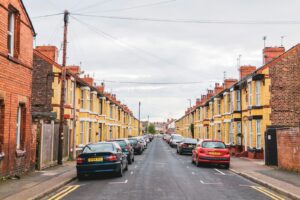How Manchester’s cultural venues are weathering regeneration
Manchester’s music venues are part of the city’s lifeblood, evoking names such as the Free Trades Hall in 1976 that famously gave rise to The Buzzcocks, Joy Division and The Smiths.
However, since the city’s regeneration was sparked by the Arndale bombing in 1996, Manchester has embarked upon a controversial private developer-led approach focused on its city centre.
In recent years much-loved small venues such as the Roadhouse, Jilly’s Rockworld and Sound Control have closed down and are being replaced with Tesco branches and luxury student accommodation.
What impact is this having on the culture of the city? Is Manchester’s claim to ‘do things differently’ still standing up?
New Start spoke with those involved with the city’s cultural venues to get a sense of how the ground has shifted.
‘Another struggle awaits’

The Star and Garter. Copyright – Gerald England.
Opening in 1803, The Star and Garter is a 200-capacity venue in the Mayfield area of Manchester city centre next to Piccadilly train station.
Since becoming a music venue in the early 1990s, this modest pub has become a Manchester institution, famous for its punk and metal gigs and its monthly Morrissey/Smiths disco night.
Location has always been a problem for the Star and Garter – while areas such as Castlefield and Ancoats have boomed with developments, the Mayfield area has been left largely derelict, and is most notorious amongst locals for being a red light district.
‘We’ve been told year on year that something was going to happen with Mayfield and it never happened,’ said Andy Martin, owner of the Star and Garter.
‘At the beginning of every year, it’s like, “Another struggle awaits!”
Now, after years of empty promises, the Mayfield area is finally set to be revived through the new Mayfield Partnership.
Awarded to the regeneration firm U&I, the plans will transform Mayfield into a brand-new urban community, featuring 1300 homes, office space, a hotel, and a 6.5 acre park.
Martin is open to the development, apparently convinced by U&I’s commitment to retain Mayfield’s heritage rather than rebuild the area from scratch, as was the case with Manchester’s Spinningfields district.
It has also been good for his business, as U&I’s openness to ‘meanwhile use’ has allowed new cultural spaces to open up, such as the 400-capacity Fairfield Social Club underneath the railway arches on Temperance Street.
‘Warehouse Project’s done a couple of gigs; there’s been some Heart stuff; Trainspotting Live was there last week and that was really good.
‘That for us is brilliant because… we can open without having a booking and people would come in after the gig or before the gig,’ Martin said.
When NewStart spoke with U&I about Mayfield earlier this year, development director James Heather said they wanted it to be ‘more authentic’, stressing their engagement with the area’s existing community.
However, Heather was reticent about how much affordable housing Mayfield will actually have, raising questions about who it will eventually attract and whether there is space for those who live there already.
While the Star and Garter’s business has improved, for now, Martin believes it will still take a lot of work to get people to discover the area.
He also fears more widely that Manchester city centre is losing its soul – while new venues are popping up as soon as they are closing, many of the newcomers are owned by the same company, with independence their brand rather than their ethos.
‘It’s competition-driven now. It’s venues just trying to compete,’ Martin said. ‘I think that’s wrong, but then you’re forced into the position where you have to because there are that many venues, there are that many bars.’
‘The beat of the drum’

Niamos. Copyright – habiloid.
While venues in the centre of Manchester are fighting for space, newer community spaces are taking root slightly further out of the city.
The latest of these is Niamos, a co-operative-led community cultural venue based in the inner city area of Hulme.
Hulme has a long-standing Afro-Caribbean community and is ‘the beat of the drum of the city’, said one of Niamos’ directors Sophie Bee calls it as we met her in Hulme bar Kim by the Sea.
Hulme, too, has been subject to regeneration in recent years as Manchester Metropolitan University built its Birley campus there, making it part of the swathe of student-land along Manchester’s Oxford Road all the way through to Withington.
Niamos has a storied history, starting life as a theatre in the early 19th century before serving as a BBC radio recording studio, then a space for Afro-Caribbean culture.
Bee proudly told us of the artists that have performed there in the past from Laurel and Hardy, the Beatles and Nina Simone to newer musicians such as Autechre and Aphex Twin.
As someone with Hulme connections dating back to her grandparents, Bee is concerned about Hulme’s revival as a student enclave and the effect that will have on the area’s character.
‘How do the students interact with that local community? How do we ensure that this doesn’t become another Fallowfield?’ Bee asked.
Bee is excited about upcoming cultural projects such as The Factory, the £110m theatre and arts venue being built on the site of the old Granada Studios which is set to open in 2021.
However, she is not convinced by the outreach of these places, believing they’ll cater more for the middle classes than a working class community like Hulme’s.
‘This city is not short of cultural spaces, but it’s short of community cultural spaces,’ she said.
Bee mentions a piece by a New York artist, which showcases the transformation of an old soap factory firstly into a squat and then new flats and bars.
This is a fate which could befall Niamos, as the venue is only secured on a six-year lease from local estate agents who bought it at auction last year.
The Hippodrome next door remains in disrepair, and Bee admits the pair combined is desirable real estate, leaving the artists who work at Niamos at risk of being pushed out.
‘It just happens time and time again with property and we’re not going to let it happen… Well, we’re trying,’ she said.
‘It’ll be a future’
When we asked Martin what U&I’s ten-year project will mean for the future of Mayfield and the Star and Garter, he was glib.
‘It’ll be a future, won’t it?’ he said. ‘We’ve had thirty years without a future, thirty years just living hand to mouth and having the occasional fundraiser to fix the roof.’
Bee is more optimistic, pointing at the prosperity hinted by Manchester’s now ever-present cranes, but also at venues such as The White Hotel which have popped up in buildings that survive amidst brand new apartments.
She is passionate about Niamos’ history – that irreplaceable thing in all of Manchester’s crumbling venues – and offers hope that old and new can co-exist in what has become a booming city.
‘[Niamos] is a beautiful, spiritual building. There have been four or five generations through that building now of people being creative, and that just makes me… All the hairs stand up on my arms and neck,’ she said. ‘We shouldn’t lose that.’















